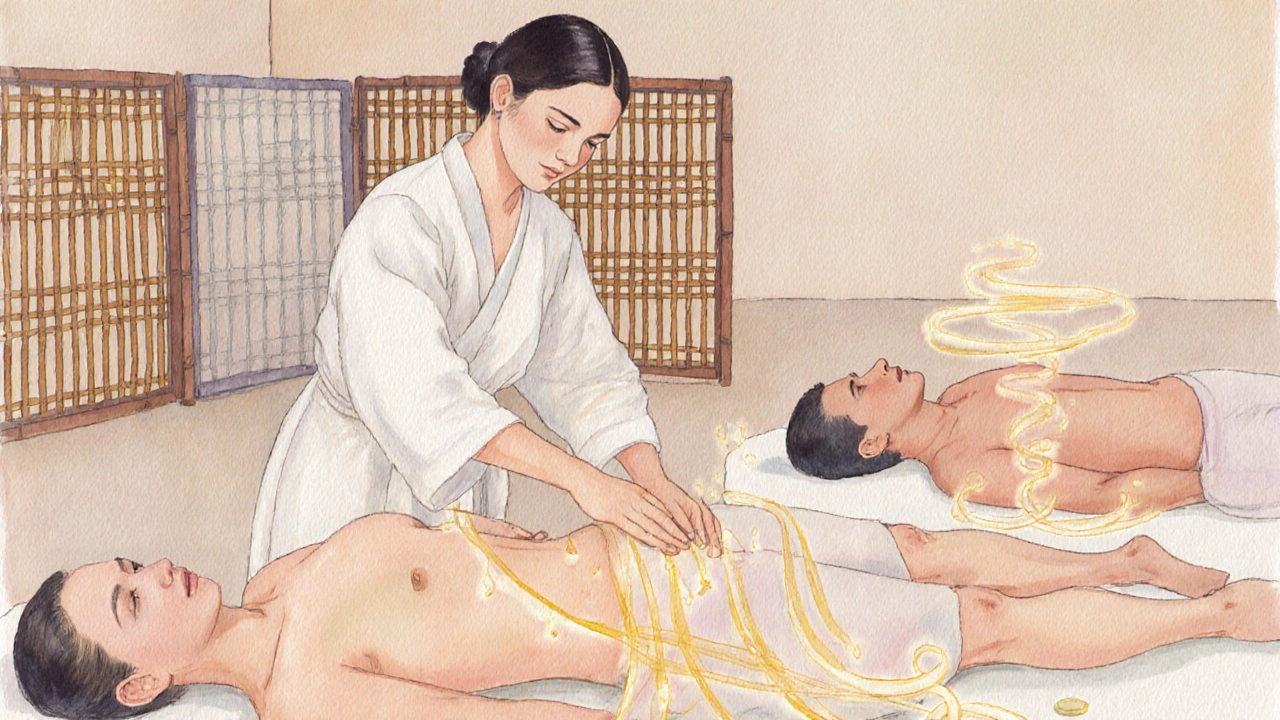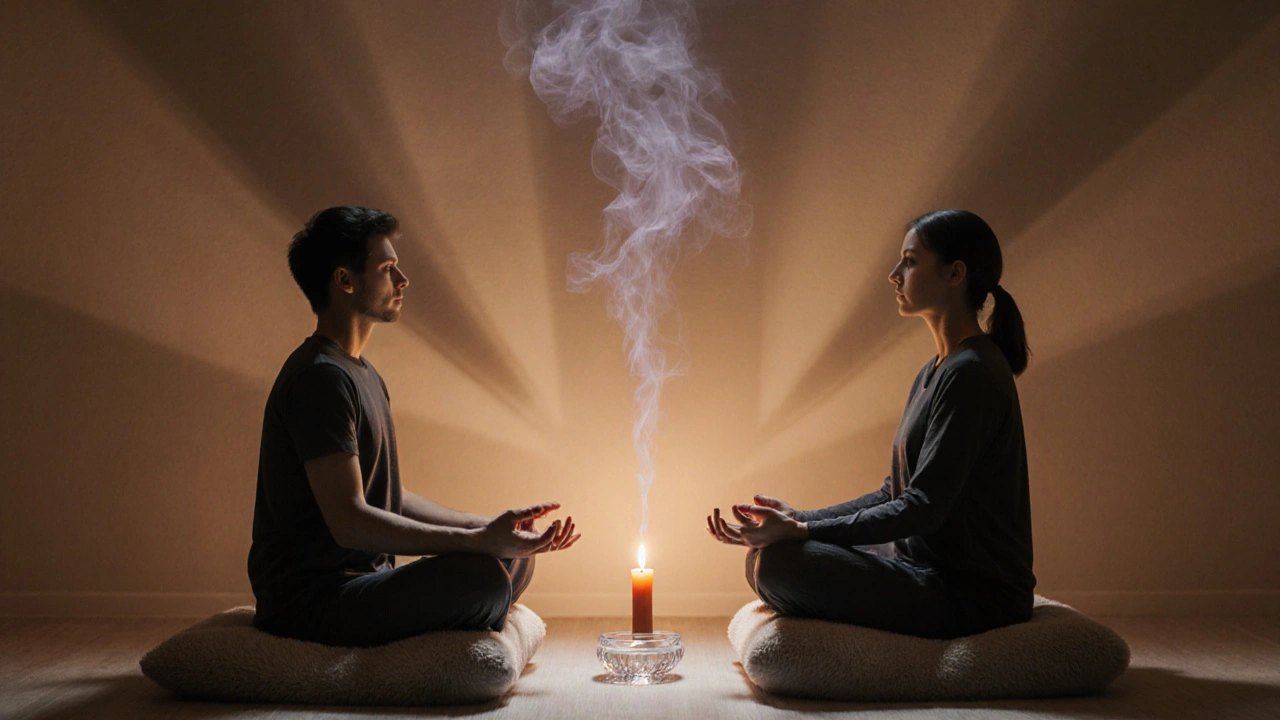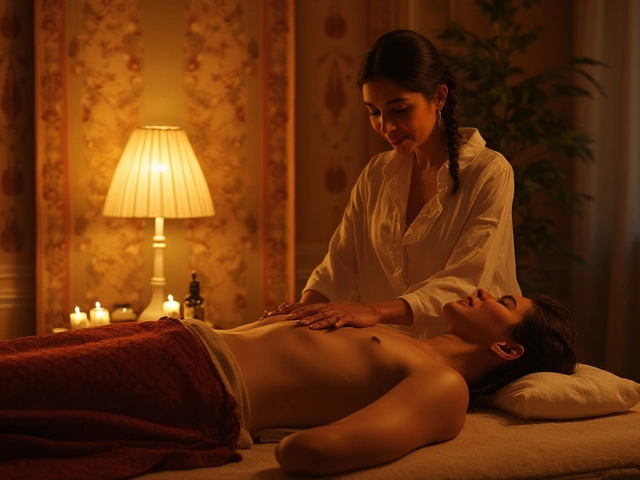When a couple feels stuck - like the spark is gone or their bodies just don’t sync - the problem often feels more than just a bedroom issue. It’s a mix of emotions, habits, and unseen energetic blocks. One practice that tackles all three at once is tantric massage - a gentle, slow‑pace bodywork that works with sexual energy rather than just muscles. Below you’ll find a clear roadmap for how this ancient technique can turn sexual incompatibility into deeper intimacy.
Key Takeaways
- Tantric massage focuses on sexual energy, not muscle tension, and helps partners feel each other's subtle signals.
- Research shows a 27% boost in oxytocin and up to 75% increase in bodily pleasure after regular sessions.
- Typical sessions last 60‑90minutes, involve shared meditation, breathing, and three specific body‑maps (joni, vajra, and pelvic area).
- Choosing a certified practitioner and setting clear boundaries are essential to avoid misunderstandings.
- Integrating tantra with ordinary relationship work (talking, scheduling intimacy time) yields the best long‑term results.
Why Sexual Incompatibility Happens
Couples often think the issue is “just sex” - that one partner wants more or less. In reality, the clash is usually deeper:
- Different energetic rhythms. Men tend to release sexual energy quickly, while women often need a slower build‑up. When partners ignore this natural timing difference, frustration builds.
- Unspoken expectations. Without open dialogue, each person assumes the other knows what they need, leading to disappointment.
- Physical blocks. Stress, past trauma, or even simple posture problems can create tension in the pelvic region, limiting pleasure for both sides.
Addressing these three layers - energy, communication, and body - is where tantric massage shines.
What Tantric Massage Actually Is
Unlike a sports or Swedish massage that targets sore muscles, tantric massage works on the bioenergetic field surrounding the sexual organs. The session usually follows this pattern:
- Opening meditation. Partners sit facing each other, breathe together, and set an intention (e.g., “to feel each other's presence”).
- Energy mapping. The practitioner gently traces the pathways of sexual energy - often called the "nadis" - using light strokes and warm oil.
- Three healing zones.
- Joni (female genital area) - deep, respectful mapping that can release blockages affecting orgasm.
- Vajra (male genital area) - similar mapping that helps with erection issues or premature ejaculation.
- Pelvic floor - the shared zone where both partners feel the most connection; releasing tension here boosts overall intimacy.
- Closing integration. After the massage, partners stay naked or covered only by a light sarong, share a few minutes of eye contact, and discuss any sensations.
Notice that the receiver stays **passive** throughout; the therapist does all the active work, which keeps the experience safe and non‑sexual.
How Tantric Massage Tackles Incompatibility
Every step of the session hits one of the three incompatibility layers:
- Energy alignment. By moving sexual energy slowly, the body learns to stay present longer. Men discover how to delay release, while women feel a gentle buildup that matches their rhythm.
- Communication boost. The shared meditation forces couples to talk about intention, breath, and feelings before any touch - a habit that easily transfers to everyday conversations.
- Physical release. Targeted work on the pelvic floor loosens muscles that might be chronically tight from stress or past trauma, creating a smoother path for pleasure.
Studies back these claims: a 2021 Czech survey found a 42% increase in overall relationship happiness after weekly tantric sessions, while a 2020 Japanese study measured a 27% rise in oxytocin levels - the hormone responsible for trust and bonding.

Step‑by‑Step Guide for Your First Session
Below is a practical checklist you can use, whether you book a professional therapist or try a home‑practice with a qualified friend.
- Choose a certified practitioner. Look for a therapist who completed at least 200hours of theory and 100hours of hands‑on training (the new Czech certification system, 2023, is a good benchmark).
- Set a clear intention. Write down what you hope to achieve - more trust, better orgasms, or simply a deeper connection.
- Create a safe space. Dim lights, warm room (around 24°C), soft music, and a clean sarong. No phones, no interruptions.
- Begin with joint breathing. Sit facing each other, inhale for four counts, exhale for six. Sync your breath for two minutes.
- Start the energy mapping. The therapist gently glides their hands along the spine, then circles the hips, encouraging the flow of sexual energy outward.
- Proceed to the three zones. Each zone lasts about 15‑20minutes. The therapist applies light pressure, uses feather‑soft strokes, and occasionally pauses to let the receiver notice sensations.
- Close with eye‑contact. Both partners stay still for a minute, feeling the lingering warmth, then share any thoughts or feelings that arose.
- Reflect later. Within 24hours, discuss what worked and what felt odd. Adjust the next session’s intention accordingly.
Doing this once a month is enough to notice changes; weekly sessions can accelerate the process, according to the 2021 University of Karlova survey.
Benefits Backed by Research
| Aspect | Tantric Massage | Classic Massage | Sex Therapy |
|---|---|---|---|
| Primary Focus | Sexual energy & pelvic integration | Muscle tension & circulation | Communication & behavioral techniques |
| Typical Session Length | 60‑90min | 30‑60min | 45‑60min |
| Main Benefits | Increased oxytocin, deeper intimacy, pelvic release | Reduced muscle pain, improved flexibility | Enhanced communication, behavioral change |
| Cost (average US$) | $120‑$180 | $70‑$110 | $150‑$250 |
Numbers come from a 2021 cross‑European study that surveyed 300 couples across 5 countries. The biggest surprise? 75% of participants reported a noticeable boost in bodily pleasure after just three tantric sessions.
Potential Risks and How to Avoid Them
Tantric massage is safe when done correctly, but a few pitfalls can turn it into a bad experience:
- Lack of boundaries. If either partner feels pressured to go beyond the passive role, tension and resentment can rise. Set clear “stop” cues before the session starts.
- Misinterpreted intention. Some men may view the practice as a covert way to explore other partners (as warned by Prozeny.cz). Openly discuss the purpose - therapy, not titillation.
- Unqualified practitioners. Always verify certifications. Poor technique can cause bruising or emotional overwhelm.
When these safeguards are in place, the majority of couples report a net positive effect on their relationship.

Finding the Right Practitioner
Here’s a quick checklist for vetting a therapist:
- Check certification - look for the Czech Association for Sexual Education (ČASV) badge or equivalent.
- Read reviews that mention “clear boundaries” and “post‑session integration.”
- Ask about their approach to consent - they should explain the passive role clearly.
- Confirm they have experience working with couples, not just individuals.
In Melbourne, studios like Harmony Tantric Spa and Inner Flow Wellness have therapists with international training and good local reputations (as of 2025).
Integrating Tantric Practice Into Everyday Life
Even if you can’t book a professional every week, you can keep the benefits flowing:
- Mini‑breathing rituals. Spend five minutes each morning syncing breath before breakfast.
- Touch‑check‑ins. During a hug, pause and notice where warmth builds - this mirrors the energy mapping.
- Weekly “energy night.” Light candles, play ambient music, and repeat one of the meditation scripts you learned from your therapist.
These tiny habits reinforce the larger session’s impact and help prevent the “backslide” many couples feel after a few weeks.
Frequently Asked Questions
Is tantric massage sexual intercourse?
No. The receiver stays passive and clothed in a thin sarong. The therapist’s role is to move energy, not to create erotic climax. Anything beyond that crosses into a different kind of intimacy and should be discussed beforehand.
How often should a couple do tantric massage?
Most studies show noticeable changes after three weekly sessions. After that, a monthly “maintenance” session keeps the energy flow open without demanding too much time.
Can I do a tantric massage at home without a professional?
Yes, if both partners feel comfortable and have learned the basic techniques from a qualified teacher. Start with short breathing exercises, keep touch light, and avoid deep pelvic work until you’ve had professional guidance.
What if one partner feels uncomfortable with nudity?
Privacy is a core principle of tantric practice. The receiver can stay fully clothed under a loose sarong, and the therapist can keep a modest drape. The key is mutual consent and clear communication before the session begins.
Will tantric massage replace sex therapy?
It can complement sex therapy but rarely replaces it. Tantra works on energy and body awareness, while therapy tackles deeper psychological patterns. Many couples benefit from a hybrid approach.






